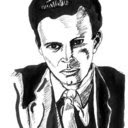"Dance! Dance! Otherwise we are lost."
Pina Bausch was unquestionably the most important advocate of dance theatre in the 20th century, and her passing in the summer of 2009 led to unanimous international applause for this passionate and illustrious genius. Wim Wenders’ wonderful documentary, Pina, is an attempt to preserve the unique spirit of her work.
In one early piece of archive footage, Pina explains that during a revival of her “Café Müller” she struggled to recapture the emotions she had felt on first performing the piece. After exhaustive rehearsing she suddenly realised that, despite the fact her eyes were closed throughout, it made an inestimable difference if her eyeballs were staring straight ahead or down towards the ground. This subtlety – teasing the most exact movements from every inch of the body – is what Pina’s art is all about.
Her choreography could be epic in scope, utilising expensive set pieces and vast companies, but the essence of her craft is most evident in the stripped-down, almost stationary, individual performances. The body constitutes its own dance company of individual limbs and sinews, all forcing one another to move in a style that is at once heavy and cumbersome and yet twitching with crazed energy. In the numerous interviews with her company members, they constantly refer to “obstacles to the spirit” and how they “always felt more than human working with Pina”. Her creations were about the mind’s desperate, paroxysmal attempts to free itself from the body. The task of translating this essence to the screen is an unenviable one, but Wenders – who knows how to uncover the poetic beauty at the intersection between landscapes and music – is well suited.
An essential part of the film – aside from the staged performances, archive footage, and interviews with the company – is the series of vignettes created and performed by the individual dancers as personal tributes to their leader. These short, intimate sequences are lifted from beneath the proscenium arch and placed in wonderfully surreal locations around the industrial landscape of Wuppertal, the home of the Tanztheater. They are most often based around Wenders’ favourite landmark, the futuristic Schwebebahn, elevated above the city streets by hulking industrial girders. In one of the most exciting examples, a long shot begins with a close-up on a pair of ballet shoes “en pointe”, and in one fluid motion takes in the entire dance and eventually views the performer as one butterfly element in a rusting, mechanical landscape. It is in these sequences that the 3D technology feels most breathtaking: fulfilling Pina’s ambition of freeing the soul from the confines of the physical world, and allowing it space to breathe.
The essence of the film is summed up beautifully by one of her young dancers: “She left everything behind and was free, that’s why I wanted to give her this moment of weightlessness.”






No comments :
Post a Comment